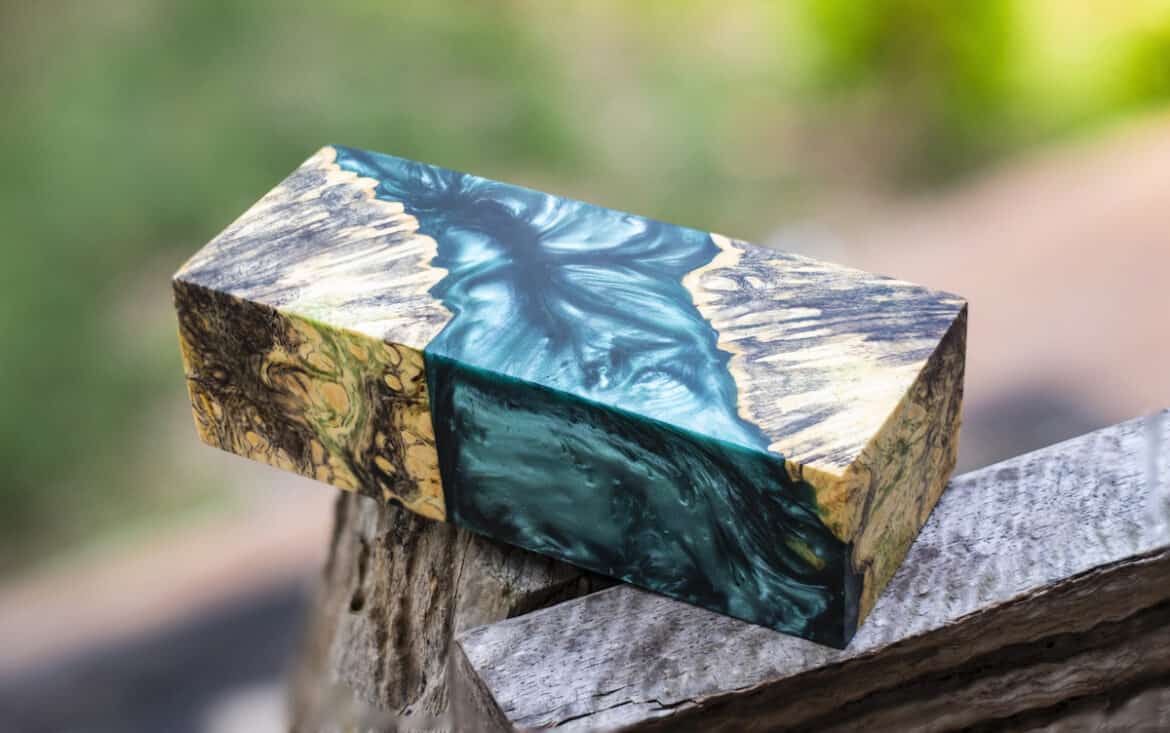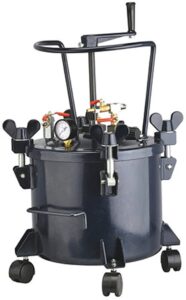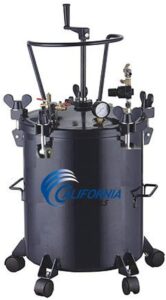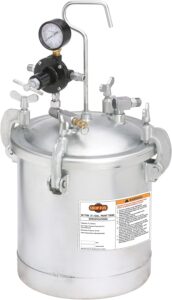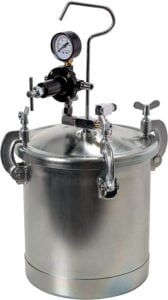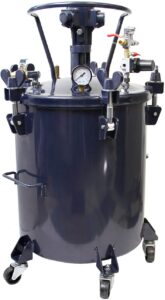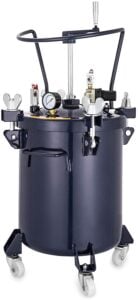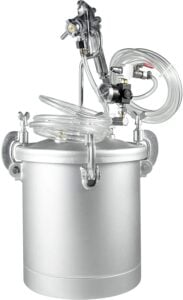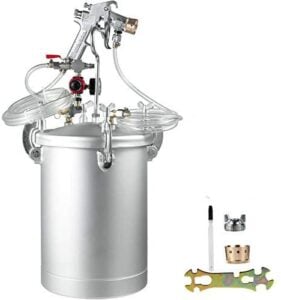Resin is undeniably one of the most beautiful materials for crafting. The crystal clarity and glass-like appearance are aesthetically satisfying. However, there’s one big hurdle when it comes to achieving this kind of perfection with resin; the formation of bubbles from trapped air.
Bubbles can develop while mixing the resin, pouring it into the mold, or contamination of the tools and vessels with moisture. Once that happens, you’ll need the help of a pressure pot to drive out all the trapped air and minimize imperfections.
What are the best pressure pots for resin? The best pressure pots for resin will be made of high-quality and durable materials like steel or steel alloys and are ASME certified for safety. They should have a higher PSI for resin, at least within the 30-60 PSI range.
In this post, we recommend the 9 best pressure pots for resin to help you get started quickly. We’ll also explain what to consider when choosing a pressure pot and explain how to use one at the end of this article. So, let’s dive in!
Why You Should Use A Pressure Pot For Resin
Anyone looking to purchase pressure pots for DIY resin casting has probably already run into the biggest problem with this kind of project; bubbles and more bubbles.
Regardless of your skill level, the bubbling of resin is an almost inevitable occurrence. When the resin hardens with these tiny air bubbles inside, the final product looks a little less than attractive and can even adversely affect its integrity.
You want the results to have that unflawed transparency that is impossible with trapped bubbles. There are a couple of ways of eliminating them, some of which you might already be familiar with.
Tapping the walls of the mold is one of them. It sends the bubbles to the top, which allows you to use a heat gun or lighter to fire them out. However, this does not help entirely when the bubbles are just too many and too deep or centered. A heat gun may also damage your mold if you’re not careful.
It would be best if you had a surefire way of getting rid of them, and that is why you should use a pressure pot for resin casting. A pressure pot for resin is the ultimate solution for bubble-free resin casting. It builds up pressure that shrinks the bubbles into microscopic sizes invisible to the naked eye, giving you a clean finish.
Choosing A Pressure Pot For Resin
Pressure pots are built for various applications even though they work in a similar fashion. You’ll find them in woodworking as well as metal fabrication workshops.
Therefore go for specifications best suited for resin casting. If you can’t find one, you can opt for a pressure pot paint tank and make a few modifications. The following are the basic things you should be looking for when buying a pressure pot for resin.
Quality
Pressure pots come in a range of prices which directly represents the quality. You get what you pay for. High-quality models are more expensive, while low-quality ones are made from cheaper materials and carry a low price tag.
You can check the workmanship, the number of features, and most importantly, the material of build to determine the quality you are getting. Steel and steel variants are strong and non-corrosive metals and make the best pressure pots.
Safety
Safety is crucial when using an unpredictable device such as a pressure pot. Pressure pots are generally safe to use even at home but can be potentially explosive if set up incorrectly. Safety features minimize this risk.
The first thing to look for when it comes to safety is the ASME certification. ASME stands for the American Society of Mechanical Engineers. A certification from this body guarantees that the pressure pot has been tested and works as it should. These models are, however, very costly.
This does not mean that a model not bearing the ASME certification mark is unsafe to use. Just that it is the ultimate way of knowing that the product won’t fail.
If you choose a pressure pot that is not certified, you may want to take extra caution and only use it in a workshop or a safe outdoor location rather than in your home, studio, or garage.
Other safety features you want to look for include a pressure release valve that allows you to discharge the excess pressure if you happen to exceed the maximum set PSI. This will prevent the pressure from causing your pot to burst or explode.
Size
Pressure pots come in various sizes. The 2.5 and 5-gallon capacity are the most common sizes and used for a wide range of small and medium projects.
There are larger sizes, namely 10 and 15-gallon pressure pots. These are mainly for industrial use unless you’re going to cast a big resin project.
Maximum PSI
A higher PSI is always better when it comes to casting resin. Ideally, you should be looking at 60 PSI or higher pressure pots. Otherwise, 30-45 PSI is the optimum PSI for curing resin.
A word of caution when buying a pressure pot, always check the maximum PSI. Do not attempt to purchase one that lacks this vital piece of information.
Whenever you exceed the maximum PSI, you risk blowing up your pressure pot. There’s no way of knowing the maximum allowed if the information is not available.
Convenience Features
Convenience features have no direct impact on the outcome of your resin but make your work easier.
Fittings like wheels enhance the portability of the pressure pot. In case you need to move it from one place to another, you will just roll it instead of carrying it because they tend to be heavy.
Another convenient feature is a broader wing on the lid clamping nuts. Wider wing nuts provide a large surface area that doesn’t hurt your fingers while you tighten them when clamping the lid of your pressure pot.
You also want to check the shape at the bottom of the tank. Is it flat or concave? Concave bottoms may tilt or warp your mold as it may not balance well if its base is not wide enough. You can insert a flat board or plate to even out the floor and counteract this issue.
The 9 Best Pressure Pots For Resin
We’ve now gotten to the favorite part of the article, and that is a list of the top contending pressure pots for resin.
| Rank | Product | Key Features |
|---|---|---|
| 1. | California Air Tools 5 Gal Pressure Pot - Teflon Coated | Made for resin casting, Teflon coating, 80 PSI |
| 2. | California Air Tools 5-Gallon Pressure Pot | Pressure release valve, 80 PSI |
| 3. | California Air Tools 10 Gallon Pressure Pot | 60 PSI, Teflon-coated steel, includes wheels |
| 4. | Shop Fox 2-¼ Gallon Paint Tank | 45 PSI, small, double output regulator |
| 5. | TCP Global 2-1/2 Gallon (10L) | Small, 40 PSI, maintains pressure overnight |
| 6. | TCP Global Commercial 10 Gallon (40L) | 60 PSI, large, commercial-grade |
| 7. | VEVOR Pressure Paint Pot 8 Gallon (30L) | Steel, 90 PSI, relief valve, includes wheels |
| 8. | VEVOR Pressure zPot Tank 10L | Small, 60 PSI, relief valve, double regulator |
| 9. | VEVOR Paint Tank 15L Pressure Pot | Steel, includes wheels, 45 PSI |
Remember, the best pressure pot is relative to your needs and budget. We recommend thinking through the factors mentioned earlier before settling for a particular model. We leave you with reviews of the 9 best pressure pots from which you can choose from.
1. California Air Tools 5 Gal Pressure Pot – Teflon Coated
One of the biggest hurdles you’ll face as a beginner when looking for a pressure pot is converting it for resin casting. However, with this 365C model, all that is in the past.
The pressure pot is explicitly created for resin casting and needs no modification to use. It is a heavy-duty pressure pot that incorporates a steel tank with a Teflon coating.
At the bottom are removable caster wheels for stability and balance. The pot also features an on/off ball valve and a pressure regulator.
Capacity-wise, the pressure pot is 5 gallons and can accommodate nearly any small and medium-sized resin projects. The maximum pressure is 80 PSI and operates optimally at 60 PSI for resin.
California Art Tools’ pressure pot is one of the most effective pressure pots for resin because it holds the same pressure for hours on end.
If you’re looking for something that’s ready to go because you do not know about making adjustments or modifications, this is the air pressure pot you need. You only want to buy an air compressor for it.
2. California Air Tools 5-Gallon Pressure Pot
California air tools 5-gallon pressure pot is one of the ideal pressure pots for resin casting. The 12 inches wide 14 ¾ inch deep internal cavity is suitable for small and medium-sized resin projects.
It has all the critical features you would want for effective resin casting, including a pressure relief valve for safety, an on/off ball valve, and a double output regulator.
This pressure pot has a maximum pressure of 80 PSI but works optimally at a strong 60PSI suitable for resin casting. The tank is made of steel and coated with Teflon that cleans with ease by simply wiping dirt off.
Its lead comes with a gasket and clamps for an airtight seal. The castor wheels can be attached and detached for mobility and stability.
This version of California Art Tools’ pressure pot comes with an inbuilt agitator meant for spraying applications. You must remove it to make the device usable for resin casting. However, this is an easy conversion and nothing major that you can’t execute on your own.
3. California Air Tools 10 Gallon Pressure Pot
If you are a full-time resin crafter and need something with ample space for a lot of resin, this pressure pot might be the right one for you.
The bigger brother of the California Art Tools 5-gallon pressure pot comes with all its exciting features but with twice the capacity.
It is a 10-gallon capacity pressure pot with more room for your resin. The dimensions of its internal space are 14 ¾ inches wide and 17 ¾ inches deep.
This California Air Tools pressure pot is registered to a maximum of 60 PSI but operates optimally between 30 and 40 PSI which is enough pressure to get your resin bubble-free.
The body is built of steel with a Teflon coating that allows easy cleaning by just wiping. At the bottom are caster wheels that enable you to glide the tank around if you need to move it. They are also removable if you want it stationary.
Among other key features are a double output regulator and an on and off ball valve. Its lid comes with a gasket and wing nuts that guarantee a tight and leak-proof seal.
Unfortunately, this pressure pot is designed for spray painting and therefore comes with a hand-operated agitator. That said, you can quickly transform it into a pressure pot for resin by removing the agitator.
Cut the agitator or remove it altogether and seal the hole using bolts, steel washers, and neoprene washers. This pressure pot is a high-end device and a long-term investment.
4. Shop Fox 2-¼ Gallon Paint Tank
If you are a small-scale resin crafter who doesn’t want something too big or to spend too much on a pressure pot, you might like this model from Shop Fox.
It has a maximum pressure of 45 PSI, working optimally at 30 PSI. Do not let its small size deceive you into dismissing its resilience and capabilities. Though small, the pressure pot has a rugged body made from galvanized steel.
It also has all the essential features for a resin casting pressure pot, including a double output regulator and a pressure relief valve for safety. The lid comes with a gasket and clamps that tighten the pot, ensuring no air seeps out.
Its inner chamber measures 10 inches in diameter and 11 inches deep. The bottom is curved, so you’ll have to insert a flat board to balance the mold. This is a well-made pressure pot and the perfect choice for the at-home resin DIYer.
5. TCP Global 2-1/2 Gallon (10L)
Another mini pressure pot for the resin craft hobbyist is the TCP global 2-½ gallon pressure pot. It is 13 inches wide and 21 inches high, with an internal diameter of 9.5 inches and 10.5 inches in depth. This pressure pot is constructed with heavy-duty steel and has a maximum pressure of 40 PSI.
The best thing about this pressure pot is that it can hold constant pressure for the amount of time needed. Therefore you can leave it overnight without worrying that air will seep out and lower the pressure.
It has a very easy clamp-on lid with a gasket for enhanced sealing. The pressure pot also features an air release valve for safety and an air pressure regulator. Beginners will delight in the fact that the manufacturer included an instructional manual inside for an easy time setting up and using the pressure pot.
Like most other pressure pots in this review, you have to perform some form of modification to make it suitable for resin casting. This includes buying a connector hose and an air compressor, as well as replacing the pressure gauge with something with a stronger PSI.
There are several other modifications that you have to do with the fittings, but at the end of it all, it is one of the strongest and the most long-lasting pressure pots you can ever come across.
6. TCP Global Commercial 10 Gallon (40L)
If you are a large-scale creator of resin casts or plan on running a business, then you need a commercial-grade pressure pot. This 10-gallon pressure pot from TCP global can accommodate large resin volumes and hold up to the task.
It features a 5-clamp lid with a gasket for airtight sealing. There’s also a double output regulator and a pressure relief valve set at 60 PSI which is the maximum pressure.
Like the other smaller TCP global pressure pot in this review, this model also requires tweaking to make it suitable for resin casting, including removing the agitators and other fittings for spray painting.
All in all, it is worth the trouble and a good buy for professional results.
7. VEVOR Pressure Paint Pot 8 Gallon (30L)
If you feel like a 5-gallon pressure pot is too small for your needs, but a 10-gallon is going overboard, Vevor has a size you might love.
This 8-gallon pressure pot from Vevor is a perfect in-between. It is made from premium quality steel parts, and the overall construction is secure and very sturdy.
The pressure pot has a maximum PSI of 90, with the relief valve set at 60 PSI. The internal dimensions of the inner stainless steel bucket are 15 inches deep and 12.3 inches in diameter.
It comes with a high-precision pressure gauge, pressure regulator, safety valves, and removable caster wheels. Like other pressure pots in this review, you must remove the stirring stick and seal the gap to make it usable for resin casting.
If you intend to use it in the future as a sprayer, you’ll alternatively unscrew the siphon pipe, loosen the locks, take the agitator out of the way by pushing it up, then tightening the locks back.
8. VEVOR Pressure Pot Tank 10L
Vevor 2.5 gallon pressure pot tank is a decent option for the entry-level resin crafter. Though small, it doesn’t disappoint in quality and performance.
Marked at 90 PSI max and the pressure relief valve set at 60 PSI, it falls within the pressure requirements for resin casting. The inner liner measures 9.5 inches in height and 9.5 inches in diameter.
The pot features a double regulator, safety valves, hose, all of which may need to be modified, including the pressure gauge, which reads in metrics.
That conversion is a small price to pay for a functional pressure pot you would have spent three times as much or more for a ready-made high-end model.
9. VEVOR Paint Tank 15L Pressure Pot
Last but not least is the 4 gallons (15litre) pressure paint pot again from Vevor.
It possesses the same great features as all the other Vevor pressure pots; solidly built tank from non-ferrous steel, removable caster wheels, and easy clamp tight-fitting lid.
The internal diameter is approximately 11 inches, and the depth is about 14 inches which is an adequate volume for most of your DIY resin needs.
80 PSI is the maximum pressure that should not be surpassed, but it will successfully debubble your resin at just 45 PSI.
Once the fittings are modified, it transforms into the perfect pressure pot for resin at an unbeatable price.
How to Use a Pressure Pot for Resin
So, you’ve likely found a product you’re considering buying. The question, then, is: how do you use a pressure pot with resin? For your sake, here are the steps to follow.
Supplies
Before you begin, you must have all of the following fittings.
- A gasket for sealing the lid
- Air compressor/pump
- ¼ inch connection hose and inlet connection
- A pressure gauge
- A relief valve
Some pressure pots come with these as part of the package, but most do not. The same applies to pressure pots built as spray tanks and needing modification.
You might have to buy them separately from your local hardware if not included in your pressure pot kit. Confirm that they are a corresponding size and PSI for your pressure pot. Once you have all this in place, follow these steps.
Steps
- Start by taking off the lid of the pressure pot. Test fit the mold you intend to use by placing it in the pressure pot before you start pouring in the resin. It may not fit in if too big, and so you’ll have to find a replacement.
- Once you confirm that the mold is a suitable size, pour your resin to about three-quarters full, then transfer it into the pressure pot. The reason you’re doing this is to avoid any spillage while you are placing it inside. When the mold is secured inside, you can fill it up to the brim.
- Next is to replace the lid and clamp it as tightly as you can. To do this evenly, turn the nuts in the opposite clamps simultaneously.
- Now attach the air compressor hose to the inlet and turn on the air compressor. Introduce the air gradually to avoid splashing your resin.
- Build up the pressure slowly to 45-60 PSI depending on the size of your pressure pot. Follow the golden rule and do not exceed the maximum recommended pressure assigned by the manufacturer.
- You can switch off the compressor now. Without any leaks, the pressure is maintained precisely where you set it.
- When the time is up, release the air slowly. The pressure pot may produce a loud sound, so don’t get startled. Once the pressure has dropped down to zero, open the lid and remove your resin.
How long should you leave your resin in the pressure pot? The resin is left in the pressure pot throughout the curing time to prevent bubbles from reappearing.
This is approximately overnight or 12 hours. However, it depends largely on the type of resin you are casting and also surrounding temperatures.
If you’re more of a visual learner, we’ve found a great tutorial by the Casual DIY channel on YouTube explaining just how to use your pressure pot.
Up Next: The Best Mold Material for Casting Resin
